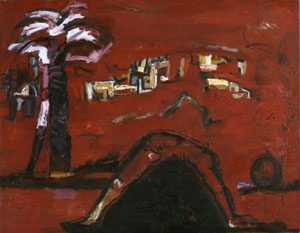The expressive image of the felled trunk has recurred in Said’s works since the 1980s. This image of the Palestinian landscape attests not only to the loss of Palestinian land in 1948 or the confiscation of land as part of the policy aimed at “Judaization of the Galilee” in the 1970s, but also to an ongoing, continuous political reality of struggle over the land. All these together generate an affinity between the traumas of the past and the present reality of the Palestinian minority in Israel. It is a post-traumatic painting repeatedly returning to the scene of the crime, to the felled trunks, to the landscape of the Palestinian village, if only in order to decipher the secret of the violence whose signs appear on the surface.
A post-traumatic consciousness has accompanied an entire series of works created since the 1990s, in which Said continually revisits Giorgio Agamben’s image of the Homo Sacer (the sacred man), the figure of the victim who is beyond language and outside the boundaries of human society. In Untitled (1992) the entire body leans on the arm, a type of giant hand which creates a triangle and a basis for physical and mental support. The wide-open, screaming mouth generates ambivalence between helplessness and defiance. The work corresponds with the Arabic maxim “malaksh g’eir d’raa’k”-“you have nothing but your arm,” or “one’s arm is one’s sole support.” The root of the Arabic word for arm (ذرع), however, is also-as in Hebrew-the root of the verb denoting to sow or seed, as well as the root of the words denoting measure and endurance. In other words, the arm is the yardstick by which the human resilience to pain and suffering is gauged. In the painting, the figure offering itself as a powerful sacrifice forms a metaphor similar to the sabra (prickly pear cactus) symbol, namely-a metaphor for tenability and tenacious clinging to the land (sumud).
In Untitled (1993), the figure of the Homo Sacer is at a distance from the village, standing against a colorful, blazing red backdrop, as if it were a bridge. This image of a human figure stretched as a bridge over the ground is inspired by depictions of the goddess Nut (Nuit) in Egyptian mythology. The Egyptians believed that Nut, the sky goddess, physically introduced a barrier from the chaotic powers threatening to break into the orderly, rational world, and therefore depicted her as a woman bowing, with the world protected under her belly. Said’s figure stretches a metaphorical bridge between chaotic forces and an orderly world underlain by inner logic, while underscoring the price-the physical and mental pain-the figure must pay for continuously straining all its muscles in an ongoing effort to bear the weight of the taut body.
The experience of a body in distress is conveyed in a series of drawings created in 1988, about a year after the outbreak of the first Intifada. These drawings in acrylic on paper portray the so-called Stone Intifada in three colors-ochre, red, and black; this ‘Greek-urn’ coloration implies a mythological tale of power and strife. In one drawing the feet of the fleeting figure merge with the ground, in sharp contrast to the hand gesture indicating flight from the soldiers represented by a schematic delineation of helmets and rifles. Created in Berlin in the 1980s and 1990s, these works address ongoing human suffering, placing man at their core as the victim of chaotic forces immeasurably greater than he.
Born in Nahaf, 1957. Lives and works in Nahaf and Berlin.
Less Reading...
